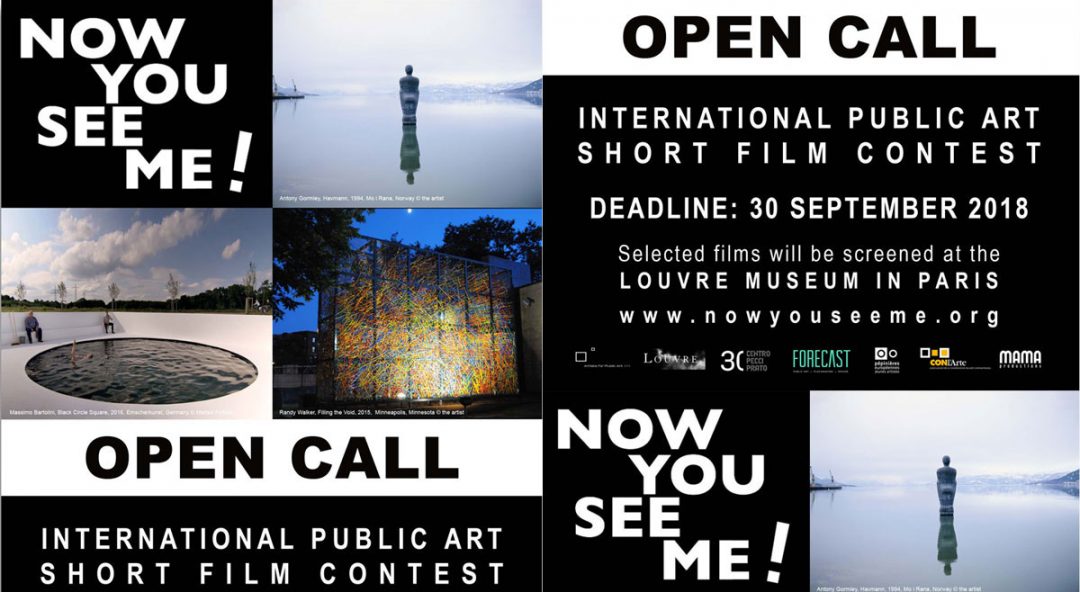Appel a candidatures :
In partnership with Pépinières Européennes de Création network, the festival Now You See Me! lanches a call for its 3rd Edition of the International Public Art Short Film Contest.
Dealine : 30st September 2018
Day(s)
:
Hour(s)
:
Minute(s)
:
Second(s)
What is Public Art?
Do you live near a work of public art?
Can you see one from your bedroom window?
Do you pass by one on your way to work?
Is there one you like in particular?
If the answer is yes, send us a short film about it!
If the answer is no, find one quickly and send us a short film about it!
The Contest
As film has become a mean of intuitive expression accessible to everyone, we invite the general public to discover the world of Public art around them, to be inspired by them and to turn their feelings and thoughts into short films.
On the local level, we believe that it would make people more familiar with works of public art around them. On the global level, it would emphasise the fact that public art is a world phenomena and that works of public art exist all around the globe.
Our aims are to raise awareness to this aspect of our urban life, to render these works of Art more visible and to create a stronger affinity between the public and public Art. We endeavour to promote the reflection of the public, especially of the younger generation, about the important role public art plays in our urban daily life.
As it is today’s younger generation who will be responsible of the protection and conservation of these works of Art in the years to come, they constitute our first port of call. We also believe that by engaging their talents and skills, we will create a cutting-edge thought-provoking collection of short films.
A jury of world-acclaimed film makers and artists will choose the best films. These films will be screened at the Louvre museum as part of its prestigious Journées internationales du Film sur l’art (International Days of Art Films) in January 2019.
FURTHER INFORMATION
International Public Art Short Film Contest
“An average of 55 million viewers experience public art first hand every day. Approximately 1,000 times the audience experiencing art galleries, museums and theaters combined” (Public Art Review, 2002)
In a world where the majority of the population is urbanized, the shape of the space shared by the citizens is not only defined by buildings, infrastructure and recreation facilities, but also by the everyday presence of art. Works of Public Art have become indispensable beacons in the cities’ squares, parks and streets.
Works of Public Art promote civic consciousness and create an essential link between the contemporary world and the shared memories of tragic episodes or moments of elation. From the most figurative to the most conceptual, they bring the excitement and the mystery of artistic creation to an audience that is sometimes intimidated by museums and exhibitions.
Once they become part of our urban space, these works of Public Art become part of the everyday life of our cities. Beyond their original meaning and purpose, they usually find unexpected uses, becoming essential references and meeting points in the daily itineraries of thousands of people.
Over the last few decades, it has become clear that Public Art has the power to energise our public spaces, arouse our thinking and transform the places where we live, work, and play into more welcoming and meaningful environments that invite interaction. Public Art can make strangers talk, children ask questions, and calm a hurried life.
Moreover, Public Art can enhance the quality of our life by encouraging a heightened sense of place. Works of art in the public domain can help transform perceptions of a neighbourhood and bring in visitors. They can define the identity of a place, evoke a sense of affinity between a site and its inhabitants, and become an icon – a symbol that represents a place.
However, many of these works of art have fallen into neglect, degradation and decay. Very little is done in order to protect and maintain Public Art. Almost no funds, no policies, no laws and no procedures exist. As a result, many of these works of art risk disappearing or becoming shameful testimonies of the indifference of our society.
The association, Artists for Public Art APA1777, was established by some of the leading players in the world of Public Art in order to change this. It has become clear to us that in order to protect the works of Public Art, they need to be appreciated and in order for them to be appreciated, they need to be seen.
Yet, as our world is becoming increasingly quick and immediate and as our everyday life is becoming increasingly busy, we seem to devote very limited time and attention to appreciate and question our immediate environment.
When we think about our cities, we usually think about roads, cars and buildings. For some reason, very few of us are conscientious of what could be regarded as a more poetic aspect in our urban landscape – the works of Public Art which surround us.
We believe that although millions of people experience Public Art first hand on a daily basis, many of them are not conscientious of its presence. Trapped in their daily routine, people walk, drive and sit by works of Public Art, but they do not always actually “see” them.
Steering Committee
- Noa Karavan-Cohen (Founder and Director)
- Jennifer Pearce (APA1777)
- Pascale Raynaud (Musée du Louvre)
- Smadar Timor (Mama Productions)
Infos
- deadline : 30.09.2018
- candidature : nowyouseeme.org
Production
- Proposed and organized by Artists for Public Art 1777.
- In partnership with the Pépinières Européennes de Création network

